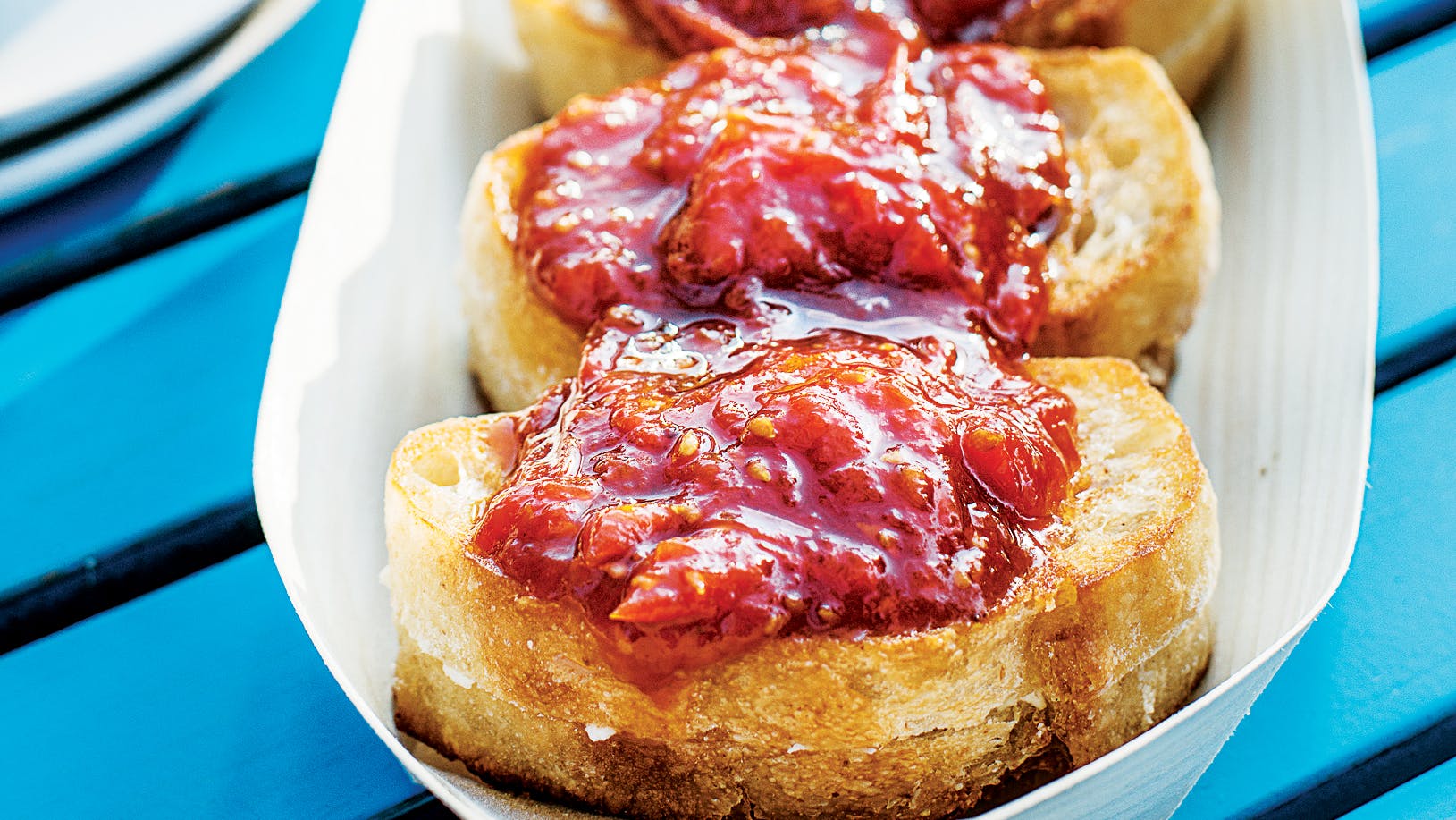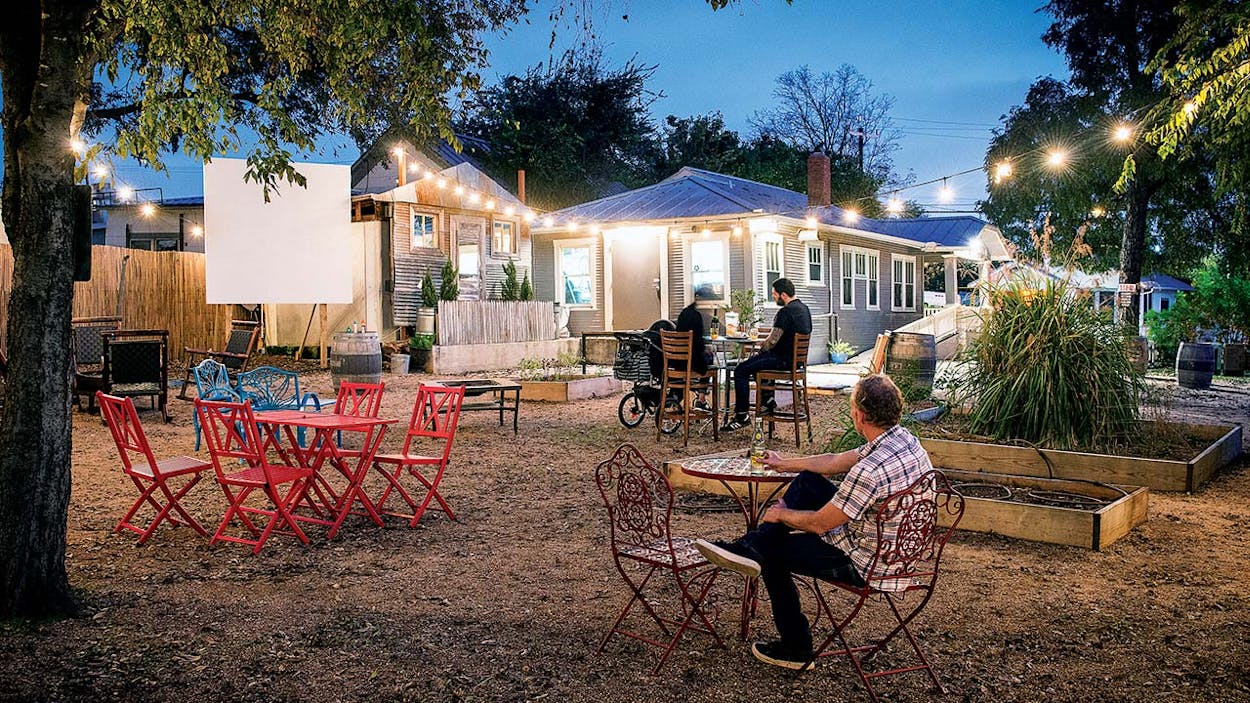This is the tapas bar I had in mind all along,” says Jason Dady, the chef and co-owner of the Bin. The forty-year-old is chatting with customers at a tall wooden table in a converted twenties-era bungalow on Grayson Street, the up-and-coming mini–restaurant row north of downtown San Antonio. It’s getting dark outside on a chilly evening in late fall, but the small frame house is warm and welcoming, with interior walls painted yellow and red and a couple of fire pits and mix-and-match tables out back. People are queueing up to order at the bar, with repeat visitors offering tips to newcomers unfamiliar with Spain’s whimsical but convoluted snack culture. One party wrestles with the vocabulary (what the heck is the difference between a tapa, a pintxo, and a montadito?) but has no trouble with the drink order: a pitcher of sangria, por favor.
Dady has been obsessed with Spain since he traveled to Barcelona as part of the Coppell High School basketball team in 1995. The allure only increased after he graduated from the California Culinary Academy, in 2000, and moved to San Antonio to open his first restaurant, in partnership with his wife, Crystal, and brother, Jake, also a chef. In 2003 he and Jake backpacked around Spain and southern France. They went back again in 2010, after they hit the jackpot and got a table at the most prestigious restaurant in the world, El Bulli, two hours from Barcelona. On the same trip, they visited Michelin-starred restaurants in the Basque city of San Sebastián. On a visit in 2012 they took time out to run with the bulls in Pamplona (“I was sure we were going to die,” he says). All the while, they kept opening restaurants back home, an ecclectic lineup that now includes a trattoria, an enoteca, a barbecue joint, a seafood shack, an icehouse, and a food truck. One of them, started in 2004, was a pleasant North Side place named Bin 555, which turned out to be the proving ground for the nostalgically named tapas bar. The original Bin closed in 2013, but, Dady says, “We learned more than if it had actually worked.” Mainly he came to appreciate the paradoxical genius of Spain’s tapas tradition. First, the space should be crowded (the Bin has two rooms and a yard). Second, the kitchen must be small (Bin’s is three hundred square feet). Third, prices should be reasonable. Finally, booze pays the bills (the Bin has a full bar, with specialties of sangria, mojitos, and “gin-tonics,” as the Spanish say).

The twenty-item menu is attractively hand-lettered on a blackboard mural, so you can plan while you move forward in the line. You’ll want a few quick bites, like a cup of marcona almonds and quicos (fat, puffy Spanish corn nuts). Some mixed olives wouldn’t be a bad idea either. Ditto for boquerones (vinegar-cured anchovies) and a plate of seared padrón peppers showered with sea salt. Another must is the justly famous Gilda, a tart little mouthful consisting of a skinny pickled guindilla pepper, an anchovy filet, and two green olives on a teeny bamboo skewer. Not only is the Gilda historic—having been created in San Sebastián in honor of Rita Hayworth, who played the title role in the 1946 movie—it also offers a look at tapa nomenclature, because, being Basque, it is technically a pintxo. (For nerds only: “pintxo” means a “skewer” or “spike.” “Tapa” translates as “lid” or “covering,” a reference to the slice of bread bartenders used to place over carafes to keep flies at bay. “Montadito” means “mounted” and is a tiny sandwich, typically open-faced.)
All of these bites are ready-made and handed to you immediately. While you work on them, you might select something that takes a few minutes to prepare, maybe slices of the best ham in the world: sweet, nutty aged jamón ibérico, made from pigs that gorge themselves on acorns. Or a plate of chorizos and cheeses, including manchego and the less-common mahón, which, says Dady, “tastes like a Gouda but has the texture of a young Parmesan.”
Since by now you may be feeling the effects of that pitcher of Rioja-based sangria, it wouldn’t be a bad idea to lay down a carb or two. One classic is the Spanish tortilla, which here takes the form of a mild potato custard pie topped with a dollop of padrón pepper crema, but personally, I like the spunkier patatas bravas, chunky fried Yukon golds zapped with cayenne, cumin, and smoked paprika and topped with squiggles of kewpie mayo. Or try the pan tomate. In Spain and other Mediterranean countries, this is a simple peasant dish, often just a piece of bread that has been rubbed with a juicy tomato. Here the slice of baguette has been amped up for American tastes and loaded with chopped San Marzano tomatoes and tricked out with olive oil and smoked paprika. There’s grilled octopus too, which I normally love, but the day I sampled it, the flavor was off.
Or you can go with the kitchen’s original creations, like a rootsy parsnip-tahini hummus with a nubby texture that works beautifully with the silky dill yogurt on top. And you might as well have the signature dish from Bin 555: goat-cheese-and-tomato-jam mini-sandwiches. A melding of sweet, funk, and sass, they were so popular at the late, lamented restaurant that the kitchen workers grew to loathe them. Dady initially refused to bring them back but relented after, he says, “My wife convinced me they’re part of our legacy.”
There are no actual desserts at the Bin, although a creditable stand-in is an order of the seductive blue cheese–stuffed medjool dates wrapped in serrano ham. But honestly, the best conclusion to an evening may simply be more liquid refreshment. There’s the gin-tonic served José Andrés–style, festively garnished with wheels of lemon and lime, as the world-famous Spanish American chef does in his restaurants. Or the porrón, which refers to both the traditional vessel—it looks like a pitcher crossed with a watering can—and the act of pouring its contents (usually wine) into the mouth. There’s no restriction on the libation—Dady says he’s seen more than one porrón filled with gin-tonics—but there is a caveat. If anybody in your group is wearing white, please don’t let them use sangria.
511 E. Grayson, San Antonio (210-994-8099). D Tue–Sat. $–$$
Opened: September 20, 2016
- More About:
- Pat’s Pick
- Jason Dady
- San Antonio









